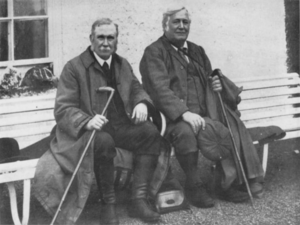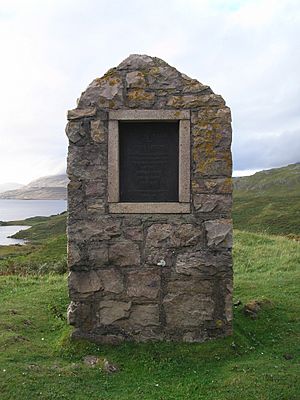John Horne facts for kids

John Horne (born January 1, 1848 – died May 30, 1928) was an important Scottish geologist. Geologists are scientists who study the Earth's rocks, layers, and history. Horne was a leader in his field and even served as the president of the Royal Society of Edinburgh, a famous scientific group, from 1915 to 1919.
Contents
A Geologist's Life and Discoveries
John Horne was born in Campsie, Scotland, in 1848. His father was a farmer. John went to school in Glasgow and later studied at the University of Glasgow. He left university when he was 19 years old.
In 1867, John Horne started working for the Scottish branch of the HM Geological Survey. This organization maps out the geology of different areas. He became a student of Ben Peach, another talented geologist. John and Ben quickly became good friends and worked together on many projects.
Solving the Highlands Mystery
One of their most famous achievements was solving a big puzzle called the "Highlands Controversy." For a long time, geologists argued about how the mountains in the Scottish Highlands were formed. John Horne was very good at thinking logically and writing clearly, while Ben Peach was skilled at understanding the hidden structures of mountains by looking at the rocks on the surface.
Together, they used their different skills to figure out the complex geology of the Highlands. Their findings were published in a very important book in 1907 called The Geological Structure of the North-West Highlands of Scotland. This book is still considered one of the most important geological studies ever written. John Horne wrote most of it himself. From 1901 to 1911, he was the Director of the Scottish branch of the Geological Survey.
Leading Scientific Societies
John Horne was recognized for his important work. In 1881, he became a member of the Royal Society of Edinburgh, a group for top scientists. He was very active in this society, serving as a council member, vice-president, and later as its president.
He also became a member of the Royal Society of London in 1900, which is another very prestigious scientific group. He was also a member of the Royal Scottish Geographical Society and led the Edinburgh Geological Society. In 1901, he and Ben Peach even wrote a section about Scotland's geology for a large book called Ordnance Gazetteer of Scotland.
In his later years, John Horne lived in Edinburgh. He passed away on May 30, 1928.
Family Life
John Horne was married to Anna Leyland Taylor, who passed away in 1926. He was also the grandfather of a well-known psychologist named Thomas Arthur Munro.
Honoring Their Work
The amazing work of John Horne and Ben Peach is remembered in Scotland.
Inchnadamph Monument
A special monument was built for them in Inchnadamph, a place where they did some of their most important research. The monument was put up in 1930. It says: "To Ben N Peach and John Horne who played the foremost part in unravelling the geological structure of the North West Highlands 1883-1897. An international tribute. Erected 1930." This shows how important their discoveries were to geologists all over the world.
Knockan Crag Statue
Later, in 2001, a statue of the two geologists was also placed at Knockan Crag, another significant geological site. These monuments help people remember the incredible contributions John Horne and Ben Peach made to understanding the Earth's history.
See also
- Knockan Crag
- Inchnadamph
- North West Highlands Geopark
- Geology of Scotland



